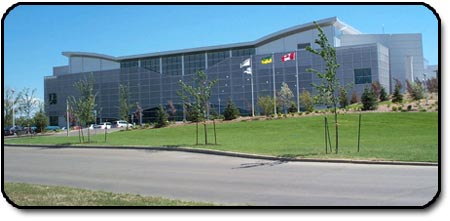

Highlights



|
 |
NRC in the Spotlight
 |
| First light in the diagnostic beamline of CLS. Colour indicates light intensity. |
On December 9th, 2003, at 6:45 p.m., in a small concrete-walled hutch in Saskatoon, a camera captured an image of a shimmering beam of light one millimetre across. This tiny spot of light marks an important milestone in the commissioning of a multi-million dollar light source which will reveal the internal structures of advanced materials and biological samples with unprecedented clarity. It reflects the successful efforts of hundreds of scientists - many of them NRC employees - and heralds a new era of innovation for Canadians. For the first time in Canada, synchrotron radiation is being made available at a national user facility, the Canadian Light Source (CLS).
The Canadian Light Source
|
Synchrotrons
The Source of a Unique Light
High energy physicists build synchrotrons to accelerate particles to the highest possible energies and then collide them to learn about the absolute smallest constituents of matter. As a circulating beam of particles is boosted to higher energies by an oscillating electric field, it takes an increasingly powerful magnetic field to get the beam to turn (much the way that it gets harder to make your car turn when driving at higher speeds). It is this synchronization of bending magnet field strength with beam energy that gives a synchrotron its name. Whenever the high-speed electrons are turned by a bending magnet they emit electromagnetic radiation (kind of like your hat flying out of the car of the previous analogy, as you round a bend). This radiation is known as synchrotron radiation.
The loss of beam energy by synchrotron radiation is a problem for high energy physicists, but it has been a tremendous boon for materials scientists, industrial researchers, biologists, chemists and environmental scientists who can use radiation at these energies to understand the properties of materials.
|
At about the size of a football field, the CLS is the largest and most expensive scientific endeavour on Canadian soil in three decades. The synchrotron functions like an enormous spotlight, shining a light on experimental samples that is millions of times brighter than sunlight. The energy of the synchrotron light ranges from the infrared through to the ultraviolet and X-ray wavelengths - perfect for probing the molecular arrangement and inter-molecular interactions which underlie the structure and function of stable, utilizable materials. Synchrotron radiation has been used by biomedical researchers to develop novel medications, by materials scientists to improve lubricants in spacecraft and by mining companies to reduce the toxicity of their tailings.
Until now, Canada's synchrotron scientists have had to travel outside of the country to collect their data, lining up at overbooked synchrotrons in, for example, Europe and the United States. But in 1999, the building of Canada's national synchrotron began. Located in Saskatoon, the CLS takes advantage of a pre-existing University of Saskatchewan electron gun and linear accelerator and has benefitted from experienced personnel with accelerator expertise.
|
CLS a State of the Art Facility
Canada's synchrotron is state of the art. It operates at a mid-range electron-beam energy of 2.9 GeV to allow for a wide range of applications. In addition to the standard synchrotron radiation beamlines associated with each bending magnet, Canada's synchrotron features wigglers and undulators, the latest technology in dedicated synchrotron light facilities, which shake the electron beam back and forth to emit a collimated beam of light with high spectral tunability, competitive in brightness with the best in the world. To restore the electron beam energy lost through synchrotron radiation, the storage ring features a single superconducting radio-frequency chamber – offering a dramatic improvement on energy efficiency compared with predecessors.
|
The CLS will launch Canadian synchrotron research onto the world stage. At full strength, the Saskatoon facility will accomodate over 30 radically different experiments on the floor at the same time. In an environment where world-class groups as diverse as, say, a physical chemist, a pediatric oncologist and a plant biologist are routinely rubbing shoulders at the coffee-machine, the potential for innovation will be phenomenal. And in an age in which scientific innovation is essential for success and prosperity, that is good for Canada.
NRC has played a lead role in charting the course for the CLS project from its inception. NRC scientists have served on planning committees and as beamline coordinators. Productive and lasting collaborations have been formed between NRC scientists and researchers from universities and private sector laboratories. Dr. Arthur Carty, NRC President and Canada's recently appointed National Science Advisor to the Prime Minister, has chaired the CLS Board of Directors. According to Dr. Carty, "The CLS, the first state-of-the-art synchrotron facility designed, built and operated in Canada is an extremely important addition to our national science facilities. It will enable a diverse community of scientists from many disciplines to work at the leading edge of rapidly advancing fields such as structural proteomics, nanostructured materials, macromolecular science, imaging and ultra high resolution spectroscopy."
 |
CLS building exterior.
Photo courtesy Canadian Light Source, University of Saskatchewan. |
NRC scientists from institutes across the country will soon have the opportunity to capitalize on their investment. The first of CLS's beamlines is already delivering data. It is just a simple diagnostic beamline recording light from the humble visible portion of the spectrum with nothing more spectacular than a camera. But what it tells us about our national synchrotron facility is fantastic news. The spotlight is on. And the fun part is about to begin.
Follow the links below to learn more about NRC projects planned for this unique facility.
Read about:
|
